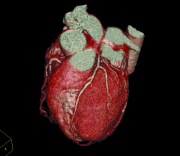Restrictive cardiomyopathy is the least common form of cardiomyopathy. This condition gets its name from the way it restricts the heart from stretching properly. While the rhythm and pumping action of the heart may be healthy, the stiff walls of the heart chambers keep them from filling normally. So blood flow is reduced, and blood that would normally enter the heart is backed up in the circulatory system. In time, the heart fails.
What causes it?
Restrictive cardiomyopathy is often caused by diseases in other parts of the body.
One known cause is cardiac amyloidosis, which is sometimes associated with cancers of the blood. Amyloidosis is a condition that causes proteins from certain blood cells (called amyloid deposits) to build up in the heart tissue, making the tissue stiff and thickened. Cardiac amyloidosis is also called "stiff heart syndrome."
Another known cause is a disorder called hemochromatosis. This disorder is passed down through family members and results in a buildup of iron in the body.
Sarcoidosis is the name of an inflammatory disease that starts as tiny, grain-like lumps called granulomas, which most often appear in your lungs or lymph nodes. The granulomas can clump together and form larger lumps that attack other organs. Sarcoidosis often affects your skin, eyes, or liver, but it can also cause restrictive cardiomyopathy. In other cases, diseases create deposits that can make the heart walls thick and stiff.
Another term for restrictive cardiomyopathy is infiltrative cardiomyopathy, because it is the "infiltration" of different materials, such as the amyloids or the granulomas, in the heart that lead to the cardiomyopathy.
Restrictive cardiomyopathy can also result from scarring of the heart, caused by a heart attack.
What are the symptoms?
Symptoms are similar to those of congestive heart failure. You may feel weak, very tired, and short of breath. Many patients have swelling in their legs (called edema). You may also find that you are sick to your stomach, bloated, and do not feel like eating. These symptoms most likely result from a buildup of fluid around your liver, stomach, and intestines. An irregular heartbeat (called an arrhythmia) and a condition called heart block are also common in restrictive cardiomyopathy.
How is it diagnosed?
Restrictive cardiomyopathy can be mistaken for a condition called constrictive pericarditis. This condition causes the sac-like membrane around the heart (the pericardium) to become inflamed and thickened. Surgery can usually correct constrictive pericarditis. On the other hand, restrictive cardiomyopathy cannot be corrected surgically. Instead, doctors will try to control its symptoms.
Diagnostic tools include the following:
- Echocardiography can be used to show the size of your heart and how much muscle damage there is.
- Computed tomography (CT) scanning gives slice-like pictures of your heart that can be used to show how the heart is working.
- Magnetic resonance imaging (MRI) can give detailed pictures of the heart and its various structures.
- A biopsy of tissue from the wall of your heart may help doctors find out how seriously your heart has been damaged, or what process may be causing the damage.
- Cardiac catheterization can show movement and force of blood through the heart (called hemodynamic analysis).
How is it treated?
Doctors may be able to treat the condition that is causing restrictive cardiomyopathy, but the heart problem itself generally cannot be reversed. Doctors currently have no way of repairing severely damaged heart muscle. So the treatment goal is mainly controlling the symptoms of restrictive cardiomyopathy. Medicines are sometimes used to ease the heart's workload and to keep a regular heart rhythm. When the condition becomes severe, a heart transplant may be needed.
Return to main topic: Cardiomyopathy
See also on other sites:
MedlinePlus
https://medlineplus.gov/ency/article/000189.htm
Restrictive cardiomyopathy
Updated August 2016



